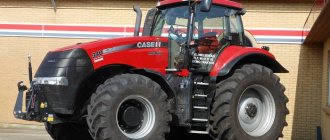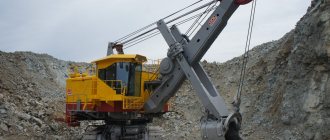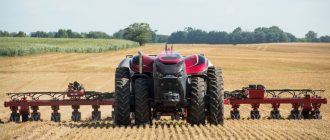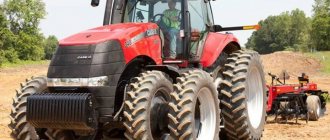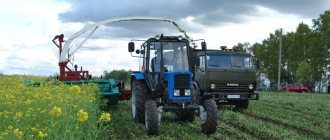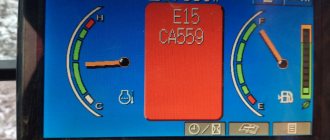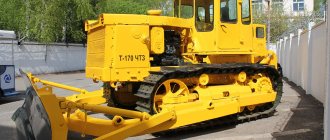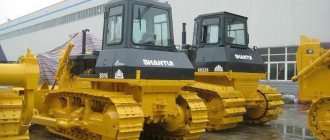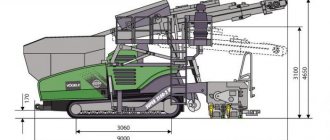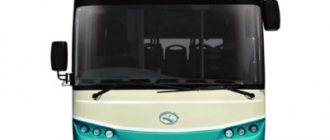Excavators
CASE was founded in 1842 by American inventor Jerome Case. The first production line operated in Racine, Wisconsin. The company's first products were threshers and steam engines. However, already in 1912, the company gained worldwide fame as a manufacturer of road equipment. In 1957, the company began producing backhoe loaders and tractors. One of the latest developments of the corporation is the production of high-performance CX series excavators, which are equipped with artificial intelligence. The first representative of the model range was presented to the general public in 2001.
General description of the Case Puma 210 tractor
With eighteen forward and six reverse gears, power shift and Autoshift as standard, the transmission offers exceptional durability in the field. And provides an excellent level of control of motor power.
The advanced diesel engines of Case Puma tractors are equipped with an electronic Common Rail injection system with the Power Boost function, which allows you to calmly cope with uneven loads due to uneven terrain and other factors that complicate work. A small turning radius helps achieve high productivity with low labor costs.
In general, the Case IH Puma 210 tractors differ:
- economical consumption of diesel fuel and lubricants;
- reliable and durable resource of the main systems and units;
- a serious level of automation, modern electronic and computer equipment;
- compatibility with attachments from various manufacturers;
- a significant degree of unification of the repair and consumable assortment.
This tractor combines optimal traction and coupling characteristics, high compatibility with the productive wide-cut mounted and trailed implements now common in large agricultural farms, comfortable working conditions for the operator, and a small amount of service and maintenance work.
The Case Puma 210 model implemented technical solutions that were useful for performance, such as:
- a power unit with flexible traction properties, combined with a refined, technically advanced transmission;
- wide range of speed modes;
- high lifting capacity of the on-board hydraulic system and universal three-point hitch.
- function of installing additional wheels.
The tractor is ideally combined with the widest range of agricultural machines for all possible purposes, which are activated by power take-off from the transmission or on-board hydraulic system. The design of the hydraulic distributor provides the operator with the opportunity to simultaneously control both the rear and front linkages.
Tractors of this model combine in their main properties the efficiency of operation of small-displacement agricultural machines with the productivity of more powerful tractors.
Case Puma 210 tractor engine
The engine of this tractor is a new generation diesel engine FPT NEF L-6, with a high pressure common fuel rail, electronic injection system and Tier 3 emissions. It is characterized by high performance, excellent fuel economy, exceptional reliability and durability.
In general, five models of tractors in the Puma family have engine power starting from 142 hp. up to 224 hp These are powerful and efficient diesel engines, four-valve, with a displacement of 6.7 liters, with turbocharging, intercooling of charge air, and low emissions. They deliver peak torque as low as 1,400 rpm (towing/hauling) and 1,600 rpm (when using power take-offs and transporting with active power management).
The FPT NEF L-6 engine produces the greatest power at a crankshaft speed of 1800–2000 rpm. There is also a constant power range of up to 600 rpm so you can maintain speed with lower motor speeds, reduced noise levels and increased efficiency.
Cylinder block type - dry liner. Intake system - turbocharger, intercooler. Fuel injection type - Common Rail, electronic, direct, high pressure. Exhaust system – with vertical outlet. Cooling system – liquid, fan driven by BorgWarner viscous coupling.
Technical parameters of the FPT NEF L-6 / Tier III engine
- Working volume – 6.7 liters.
- Rated power of ECE R120 – 21З hp. (156 kW).
- Maximum torque – 984 N.m.
- Cylinder diameter – 104 mm.
- The piston stroke is 132 mm.
- The volume of the fuel tank is 412 liters of diesel fuel.
Hydraulic system
Torque control system for a hydraulic axial piston pump with variable hydraulic oil flow – optimal engine loading during heavy work. Hydraulic pumps - axial piston type - are structurally modified in accordance with modern requirements to reduce friction and power losses. The relief system when pressure increases during overloads on turns and hydraulic shocks protects the hydraulic system from damage and reduces fuel costs.
The hydraulic excavator on CASE sh210 tracks is distinguished by: increased digging effort, high turning torque of the platform. The volume of the fuel tank has increased by 20% - this reduces the downtime of the machine when refueling with diesel fuel. Functionality for additional power increase Power Boost - provides convenience and reduces task completion time.
Transmission Case Puma 210
Puma tractors are equipped as standard with a Semi Power Shift 18×6 transmission, providing a maximum travel speed of 40 km/h. The transmission of this tractor is also equipped with an automatic gear shift system within limits to operate in automatic mode and maintain the optimal operating range of the engine. Starting from seventh gear, the transmission operates in automatic mode. The presence of six reverse gears partially compensates for the lack of a reverse function.
In the basic configuration, the Puma 210 tractor is equipped with independent power take-off shafts with rotation speeds of 540E / 1000 rpm. To ensure the highest possible efficiency, the power take-off shaft is driven directly from the diesel engine flywheel.
The design of the Power Shift TM multi-speed automatic gearbox allows gear shifting without interrupting the power flow. This feature allows you to use the traction characteristics of the power unit with the highest possible efficiency. The automatic transmission partially or completely compensates for the mistakes that the machine operator may make when choosing the currently required working or transport speed mode of the tractor.
As an option, there is also a Case Puma 210 tractor with a gearbox equipped with an additional 19th speed. On it, the tractor can travel at transport speeds of 40 km/h and 50 km/h. The optional 19th gear at 1,650 rpm improves fuel efficiency and performance while also reducing noise when traveling at maximum road speeds.
For mechanical drive of attachments, front and rear, mechanical drives from power take-off shafts are used.
Suspension, chassis, tractor brakes
The chassis of the Case IH Puma 210 tractors is all-wheel drive, with a plug-in front axle and a differential locking function. The rear wheels are constantly driven, and the front wheels are steered. The front axle is connected automatically when the wheels begin to slip, or when the load on the towing device increases significantly.
A reduction in specific ground pressure can be achieved by using twin wheels on wide-profile pneumatic tires, size 600/65R28 or 710/70R38.
Thanks to a chassis design with a very compact steering layout, Case Puma 210 tractors take less time to turn around field edges. This is especially useful when processing row crops. The Case IH front axle is designed for maximum structural strength and durability.
An additional active front axle suspension is also available on all models. It allows you to increase comfort when moving the tractor and improve its control. Guarantees less vibration when driving at speed with attachments already installed or when maneuvering a loader. The stroke length is 105 mm, and damping is controlled by an advanced accumulator and regenerative valve system, providing a smoother ride. The suspension is also equipped with an automatic self-leveling function, depending on the load.
Location and type of final drives: planetary, built into the bridge. Axle shaft type – flange. Type of service brakes: multi-disc, oil bath.
Cost of a new and used tractor
A new Case IH Puma tractor starts at $85,000. This is a significant price for most Russian buyers, especially private entrepreneurs. They can take advantage of offers of used cars, of which there are enough on the domestic market. The cost of used equipment produced in 2008–2012 varies from 2.7 to 4.3 million rubles. This is a lot, but given the long service life of the tractor, this option seems very attractive to domestic consumers.
Case Puma 210 hydraulic system and rear hitch
The hydraulic system of this tractor is driven by a variable displacement piston pump. It provides a capacity of 113 liters per minute - for tractors equipped with a full Semi Powershift transmission; up to 150 liters per minute for tractors equipped with Full Powershift transmission, and up to 170 liters per minute on CVT series tractors. Hydraulic system type: flow/pressure compensated.
Up to four mechanical valves are available as standard, or up to 5 electronic remote valves, and up to 4 electronic intermediate valves can be selected. The rear hitch provides a lifting capacity of up to 6,016 kilograms.
The hitch also offers push-button control even outside the cab, thanks to the fender-mounted control panel - for one-handed operation of the attachment.
Attachable units with hydraulic motors are connected to the on-board hydraulics using special quick-release fittings.
The three-point hitch belongs to category 3 / 3N. Traction force control is electronic, on the lower lever. Standard load capacity of the hitch - at a distance of 610 mm behind the attachment points: 6016 kilograms. Rotating drawbar, third category.
Features of ISUSU diesel engine designs
Isusu engine – 4-cylinder, low-speed, fully compliant with Tier III standard.
The reinforced cylinder block, frame and other component reinforcements mean excellent operation and high suitability of the internal combustion engine for repair. Engine noise is reduced by installing a radiator cooler operating at low speed. A fuel cooler, Intercooler, and Turbo compressor improve the filling of the cylinders with the working mixture, increase power, and reduce gas toxicity. Fuel consumption is monitored by a computer. To manufacture an engine of Tier III standard, technology for constructing large machines has been introduced. Additional purification of exhaust gases EGR – reducing the load on the external environment.
Technical characteristics of Case CX210
Max. digging depth……6.71 m Operating weight……19700 kg Breakout force……141.1 kN Operating power……105 kWt Digging height……9.65 m Reach……9.96 m Minimum fuel consumption, liters/hour ……n/a Estimated price:……n/a Average market price of an excavator, thousand rubles…….n/a Productive volume of the bucket……n/a Max. bucket volume……1.25 m3 Productivity, m/cubic…….n/a Fuel consumption in operating mode, liters per hour……n/a
Category: CASE
Technical specifications in numbers
- Wheelbase, MFD/4WD – 2884 mm.
- Overall dimensions: length – 5000 mm, width (with conventional wheels) – 2682 mm, height – 3100 mm.
- Tractor weight – 7300 kg (without ballast), 8335 kg (with ballast loads).
- The maximum permissible weight is 13,000 kilograms.
- Engine power FPT NEF L-6 / Tier III – nominal 157 kW / 213 hp, maximum 164 kW / 238 hp, nominal speed – 2200 rpm.
- Power to the power take-off shaft – 180 hp.
- PTO speed – 540 / 1000 rpm.
- The voltage in the tractor's on-board electrical network is 12 Volts.
- Maximum generator current – 150A standard / 200A opt.
- Transmission – 18 x 6 Semi PowerShift; 18 x 6 Full PowerShift; CVT.
- The maximum speed when moving forward is 40 km/h (50 km/h with an additional 19th speed).
- Standard wheel size: front – 600/65R28, rear – 710/70R38.
Distinctive features
CASE CX excavators have virtually no differences within the model range. All modifications are equipped with a robotic control system, which so far has no analogues in the world. All power plants fully comply with the international Tier III level, fuel consumption is controlled by the on-board computer.
Key differences are in engine power, track width and boom reach. These features have a slight effect on the performance of the equipment compared to other machines in the model range.
Case Puma 210 tractor cabin
The cabin of the Case Puma family of tractors, created with proprietary Surround Vision technology, is positioned by the manufacturer as the best cabin in the class, and deservedly so. It is made taking into account increasing productivity and ensuring operator comfort. The cabin is equipped with glazing with a total area of 5.87 square meters (including a transparent sunroof).
Its main characteristic differences are unsurpassed viewing angles in all directions, ergonomic placement of controls, and functions that are carefully adjusted to be convenient for the operator. Easy-to-reach, adjustable armrest controls make long periods of work in the field much less tiring.
All the most important tractor controls are integrated into the operator's seat armrest for immediate access (multifunctional Multicontroller system). It also includes an additional built-in electro-hydraulic joystick, which ensures ergonomic operation of the loader. The right front instrument panel, mounted on an A-post, provides easy visibility of important operating information for less fatigue.
Driver's cabin
The cabin of the sh210 earthmoving machine is on liquid hydraulic supports, which reduce vibration noise when digging and moving the excavator; there is more space in it, the convenience of work and the thoughtfulness of the workspace have increased. The rigidity of the cabin has increased due to special triple structural reinforcements. The intuitive display panel and control levers reduce operator fatigue. A wide glazing area makes it possible to perfectly view and keep the existing construction site under full control of the operator. Electrical components: microcircuits, blocks, computer are mounted behind the driver’s seat - while they are in optimal temperature conditions.
Reviews of Case IH Puma 210 tractors
There are few tractors of this model in agricultural farms in our country: the high cost of the tractor itself, and, of course, spare parts, components and consumables for it, characteristic of all European-made agricultural machines, has an impact. Also, potential buyers are stopped by the lower engine power, in comparison with similar European analogues, and the lack of information and software for independently troubleshooting computer failures.
However, those who operate this tractor on their land characterize it as excellent in all respects, on which almost all the hard work on the farm rests. The cabin interior is no less comfortable and cozy than in a prestigious SUV, although, of course, you have to get used to the layout of the equipment and many controls. After the warranty expires, the cost of branded service becomes very expensive, so owners prefer to deal with replacing oils and filters on their own.
According to reviews, one 210-horsepower Case Puma copes with the same amount of work that was previously performed by two T-150s. According to the peasants, the funds invested in its purchase and maintenance are justified - due to the lack of downtime, diesel fuel savings and the long service life of the main components and mechanisms.
As a disadvantage, there is a high sensitivity of the tractor engine to the quality of diesel fuel, which manifests itself in a decrease in traction characteristics and increased diesel consumption. But the main disadvantage is, of course, the high cost of spare parts, consumables and service work.
Therefore, as noted earlier, owners prefer to carry out maintenance of Puma series tractors themselves. Moreover, it is not difficult: these agricultural machines provide unsurpassedly simple access for maintenance. Their design of tractors makes it easy to carry out all planned manipulations with the replacement of technical fluids and filters.
In terms of power and characteristics, the Case IH Puma 210 tractor is comparable to the following “classmates”: KhTZ-17221; John Deere Episode 7.
Advantages and disadvantages
The Case IH Puma 210 tractor belongs to a popular series of agricultural equipment specially designed for the agricultural sector. The design of the model is largely focused on the previous Case Magnum model. For this reason, the tractor is often called the Mini-Magnum. At the same time, the unit in the Puma’s engine compartment produces 213 horsepower, which allows the compact tractor to perform tasks of increased complexity. Also worth noting is the Power-Boost technology, which ensures optimal power performance.
When developing the IH Puma Case series, the designers' priority was maximum efficiency. The result was a line of several models with a capacity of 165-213 hp. With. The equipment was equipped with a modern transmission, which includes the Autoshift function as standard. Together with the improved gear shift mechanism, it performed well in the most difficult conditions.
The Puma case is ideal for:
- harrowing;
- plowing;
- sowing;
- growing various crops;
- harvesting;
- hay preparation;
- transportation of various goods.
Its use is no less effective when collecting waste, towing equipment and trailers, as well as preparing the site for construction (leveling the soil, removing construction waste, removing snow).
The main disadvantage of the tractor is its high price. Case IH Puma 210 is a premium model and is priced accordingly. Maintaining and repairing the machine will also be expensive. For the Russian consumer, such a limitation may be decisive. However, taking into account the savings on consumables and long service life, the equipment shows a good return on investment.
